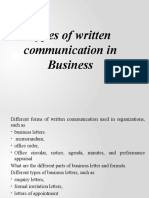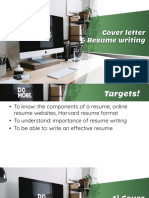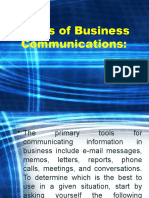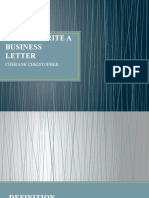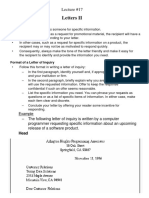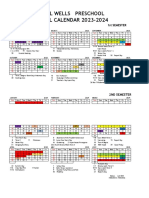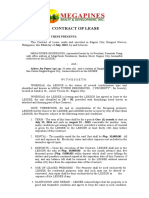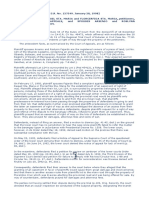Reviewer ENGL112
Reviewer ENGL112
Uploaded by
FrederickCopyright:
Available Formats
Reviewer ENGL112
Reviewer ENGL112
Uploaded by
FrederickOriginal Description:
Original Title
Copyright
Available Formats
Share this document
Did you find this document useful?
Is this content inappropriate?
Copyright:
Available Formats
Reviewer ENGL112
Reviewer ENGL112
Uploaded by
FrederickCopyright:
Available Formats
Business Letters - is a type of letter which serves as a means of communication written for various
commercial purposes. These purposes can be a business deal, complaint, notice, invitation, information,
apology, and various other corporate matters.
Why Write Business Letters?
• To persuade
• To inform
• To request
• To express appreciation
• To remind
• To apologize
• To congratulate
• To reject a proposal or an offer
• To introduce a person or policy
• To invite or welcome
• To follow up
Qualities of a Business Letter
Inner Quality - quality of language used and the presentation of a business letter
• Clear
• Simple
• Concise
• Concrete
• Accuracy
• Coherent
• Complete
• Relevance
• Courteous
• Neatness
Outer Quality - quality of its outer appearance
• Size of the paper (short)
• Quality of the paper
• The color of the paper
• Folding of paper
• Envelope
Basic/Primary Parts of a Business Letter
1. Heading - usually contains the name and address of the business or an organization, email address,
contact number, logo, etc.
2.Dateline - the date the letter was written.
3.Inside Address - includes the name, address, and job title of the recipient.
4.Salutation - serves as the welcome part of the letter.
5. Body - where you write the details of your business letter
6. Complimentary Close - serves as the farewell part of the letter.
Examples: Sincerely, Yours truly, best regards
7. Signature Block - consists of the name of the signatory, written signature, and his designation.
Secondary Parts of the Letter
Personal or Confidential Notation - used to indicate that only the person addressed should read it.
Attention Line - directs the letter to a specific individual within the company.
Subject Line - quickly identifies the purpose of the letter.
Typist’s Initials - identifies who typed the letter if different from the writer.
5. Enclosures - indicates the attached documents to the letter
6.Copies Line
• Carbon Copy - includes a list of people to whom an exact copy is being sent
• Blind Carbon Copy - used when recipient must not know that copies have been sent to others;
never appears on original letter.
7. Postscript - used when the writer wants to emphasize a point in the body.
Letter Styles or Forms of Indention
1.Block Style/Purely Block Style
All parts of the letter are left justified, except the letter head.
2.Modified Block Style
The date, complimentary close, and signature block begin near the center going to the right margin.
3.Semi-block Style
It is like the modified block except that each paragraph is indented instead of left justified.
Kinds of Business Letters
Employment-Related Letters
• Application Letter
- Solicited
- Unsolicited
• Resignation
• Termination
• Recommendation
• Appointment
• Acceptance
• Refusal
Routine Business Letters
• Inquiry Letter
• Reply Letter
• Follow-up Letter
• Sales Letter
• Order Letter
• Complaint Letter
• Adjustment Letter
• Acknowledgment Letter
• Cover Letter
• Invitation Letter
Differences Between a Business Letter and a Social Letter
Purpose:
Business Letter - To sell, to buy, or to promote a good business relationship
Social Letter - To promote or terminate a good social relationship
Subject/Content:
Business Letter - Financial or money matter, business-related topics
Social Letter - Variety of topics not related to business
Format:
Business Letter - Formal
Social Letter - Informal
Letter Parts:
Business Letter - Basic and miscellaneous parts
Social Letter - Basic parts, except inside address
Language:
BL - Business parlance, commercialese
SL - Layman’s language
Emotionality:
BL - Unemotional
SL – Emotional
What is a Resume?
• An outlined formal summary of one’s background in a clear and precise format.
• A formal document that a job applicant creates to itemize their qualifications for a position
• A document that tells prospective employers exactly what you want them to know about you
and why you would be a good fit for their open position
Why do you need a Resume
• Hiring managers use resumes to screen potential employees
• A marketing tool
• To obtain an interview, not a job
• Requirement of many organizations
Most Resumes Contain:
• Personal contact information
• Objective
• Education
• Experience
• Awards
• Activities
• Computer Skills
• References
TYPES/FORMATS OF RESUME
• Chronological Resume - presents the experiences of the applicant arranged in time sequence.
• Functional Resume - focuses on the skills and abilities, rather than the chronological work
history.
• Combination Resume - combines the best aspects of a functional resume and a chronological
resume.
Reminders in Writing a Resume
1. Keep it brief – usually two pages maximum.
2. Avoid unnecessary personal details such as age, religion, and sex.
3. List educational institutions and qualifications in reverse chronological order.
4. Include computer skills, language skills, and any relevant trainings.
5. The contents must be thoroughly checked to avoid errors.
Curriculum Vitae (CV) - Latin for “course of life”
• Often shortened as CV
• A detailed document highlighting your professional and academic history
• The ‘First Impression’ in the selection process that could land you on a new career path
Curriculum Vitae
• One of the parts of a thesis or dissertation usually found at the end
• In the United States and most of Europe, resume and CVs are not interchangeable
• In India, South Africa and Australia, the terms CV and resume are interchangeable
Standard Format of a CV
• Contact Information.
• Personal Statement.
• Professional Experience.
• Academic History.
• Key Skills and Qualifications.
• Industry Awards.
• Professional Certifications.
• Publications.
• Professional Affiliations.
• Conferences Attended.
• Additional Training.
Resume vs Curriculum Vitae
Resume:
• Emphasizes skills
• One-to-two-pages
• Used when applying for a position in industry,
• non-profit, and public sector
Curriculum Vitae:
• Emphasizes academic accomplishments
• Longer (no length limit)
• Used when applying for positions in academe,
• fellowships and grants
What is an Email
• Short for electronic mail
• Send and receive messages over the internet
• Must have an email account online
• Email is the Internet’s version of the postal
• service and a great way to communicate with people.
Uses of Email
• You can contact people anytime, and they can respond on their own schedule.
• A respectful way to communicate without interrupting someone’s day.
• Anyone with an internet connection can stay in touch with just a click.
• Useful for educational purposes, such as applying for admission or receiving job offers.
Kinds of Email
Formal Email- Sent to someone you do not know well or to someone who is in authority. Has the basic
parts of a business letter.
Informal Email - More conversational tone like a telephone call. Usually between people who know each
other well.
Very Informal Email - Similar to texting. Sent to colleagues with whom you have a close working
relationship.
PERSONAL vs PROFESSIONAL EMAILS
Personal Email:
• Informal
• Between friends and family
• Informal language
• Slang; Emojis
Professional Email:
• Formal
• Between business professionals
• Peer to peer, subordinate to boss, client to
• business, etc.
• Formal Language
Advantages of Email
• Emails provides faster and easy mean of communication.
• Email can be sent at any hour of day, thus ensures timeliness of message.
• It is secure and reliable method to deliver our message.
• It also provides facility for edition and formatting of textual messages.
• It is effective and cheap means of communication because single message can be sent to
multiple people at same time.
• It is environment friendly because there is no need of any kind of paper.
What is a Memorandum
• Latin word which means “something to remember”
• Often shortened to “memo”
• Short message or record used for internal communication in a business.
• Written report that is prepared for a person or committee in order to provide them with
information about a particular matter.
When to Write a Business Memo
• Announce or confirm a meeting or event
• Provide instructions
• Provide a status report on a project
• Request feedback or recommendations
• Summarize action required after a meeting
• Clarify or change a policy or procedure
• Distribute minutes or handouts from a meeting or event
• Provide a short report of an event or decision
Structure of a Memo
Part 1: HEADER
• TO: provide the names and titles of everyone who will receive your memo
• FROM: provide your complete name and title
• DATE: provide the complete and accurate date – do not forget to include the year
• SUBJECT: provide a brief, yet specific description of what the memo is about
Part 2: MESSAGE
• Introduction – explain the purpose
• Body – addresses the information required
• Conclusion – (Summary and possible recommendations)
Note:
- Each paragraph contains one main idea or point.
- A paragraph can be one sentence long.
- Arrange points in a logical sequence.
Presentation of your Memo
Ensure your memo:
• is Word-processed has a simple and professional look
• is centered on the page from top to bottom
• is left justified, with single or 1.5 spacing within paragraphs and double spacing between
paragraphs
• Uses a 12-point font size and a standard font like Times New Roman or Arial that is easy to read
• Includes sufficient white space to enhance clarity
Tips for writing your memo
• Your memos should be succinct, formal, clear, interesting, and easy to read
• It should be logically organized, accurate, well-researched and informative
• Avoid using technical jargon and abbreviations that the recipient may not understand
• Avoid the use of slang, colloquialisms, and contractions.
• Use action verbs and action voice to convey your confidence
• Check for correct grammar, spelling, and punctuation
You might also like
- Adult Men With ADHDDocument144 pagesAdult Men With ADHDarmy.man0222No ratings yet
- 1.RICS-Mandatory Competencies in DetailDocument23 pages1.RICS-Mandatory Competencies in Detailjdarfer100% (6)
- Mindy Sturge Vs SEIU-UHW and Marcus Hatcher (July 10, 2018)Document11 pagesMindy Sturge Vs SEIU-UHW and Marcus Hatcher (July 10, 2018)Anonymous iC9QziK100% (1)
- Technical English 2 - Module 4Document48 pagesTechnical English 2 - Module 4chandanaramesh239No ratings yet
- MC 4. Business Letters and ReportsDocument79 pagesMC 4. Business Letters and ReportsHariprasad bhatNo ratings yet
- Letter and Resume Writing FinalDocument63 pagesLetter and Resume Writing FinalArnav GuptaNo ratings yet
- M.Communication Unit 3.pptxDocument50 pagesM.Communication Unit 3.pptxWhite devilNo ratings yet
- 3.1 - Common Business DocumentsDocument31 pages3.1 - Common Business DocumentsDaniella Marie AbrogarNo ratings yet
- Communication Unit 4Document69 pagesCommunication Unit 4ulalaNo ratings yet
- Bba141 FPD 21 2023 1Document30 pagesBba141 FPD 21 2023 1chilupeesnartNo ratings yet
- Module 3Document39 pagesModule 3Dr Rema GopalanNo ratings yet
- Module 3 - Business LettersDocument48 pagesModule 3 - Business LettersShruthi MakanurNo ratings yet
- Business LettersDocument78 pagesBusiness Lettersitsnimo123No ratings yet
- Topic 5: Business Letter Dr. Richard Jaffu Department of Business AdministrationDocument28 pagesTopic 5: Business Letter Dr. Richard Jaffu Department of Business AdministrationSAMSONI lucasNo ratings yet
- EC Lesson 8 - UpdatedDocument16 pagesEC Lesson 8 - UpdatedNavinn KumaranNo ratings yet
- Business Letter: Focus: - Mechanical Structure - Types of Business Letter - LanguageDocument36 pagesBusiness Letter: Focus: - Mechanical Structure - Types of Business Letter - LanguageNur Rizki ApriliyantoNo ratings yet
- LETTERSDocument18 pagesLETTERSShahnawazNo ratings yet
- Business Letter Group 2Document38 pagesBusiness Letter Group 2Novim jr MatunnoNo ratings yet
- BUSINESS CORRESPONDENCE Format and StyleDocument20 pagesBUSINESS CORRESPONDENCE Format and StylemudimbiyibenitaNo ratings yet
- COMM01 Chapter8Document30 pagesCOMM01 Chapter8iane.tarrigaNo ratings yet
- 5.business WritingDocument39 pages5.business WritingBuhroy R BuhroyNo ratings yet
- Securing The Job by DR Jinesh MathewDocument44 pagesSecuring The Job by DR Jinesh MathewJineshNo ratings yet
- Communication Skill BBA 1 Year: Unit - 4Document18 pagesCommunication Skill BBA 1 Year: Unit - 4sakshisharma9559No ratings yet
- Dr. Sakshi YadavDocument33 pagesDr. Sakshi YadavSakshi YadavNo ratings yet
- Written CommunicationDocument94 pagesWritten CommunicationVanessa Paragas GineteNo ratings yet
- Group 2-Business-LetterDocument15 pagesGroup 2-Business-LetterJohn Vincent MiparanumNo ratings yet
- Formal Letter WritingDocument13 pagesFormal Letter WritingShin YeiNo ratings yet
- Business Correspondence Ppt2Document13 pagesBusiness Correspondence Ppt2Siwala CainNo ratings yet
- 07 Purposeful Writing For ProfessionsDocument32 pages07 Purposeful Writing For Professionsalayanjoshua26No ratings yet
- Written CommunicationDocument29 pagesWritten Communicationmolidobernard21No ratings yet
- Business Letters: Submitted ToDocument31 pagesBusiness Letters: Submitted Topoojadixit9010No ratings yet
- Career Element, Curriculum Vitae and Cover Letter: Chance of Getting An InterviewDocument10 pagesCareer Element, Curriculum Vitae and Cover Letter: Chance of Getting An InterviewSaruNo ratings yet
- Business Correspondence and Employability SkillsDocument25 pagesBusiness Correspondence and Employability Skillsabdulwahabzahid995No ratings yet
- Official & Business Letter Writing: CO1-Write Professionally in Simple and Correct EnglishDocument31 pagesOfficial & Business Letter Writing: CO1-Write Professionally in Simple and Correct EnglishShraddha SinghalNo ratings yet
- Written Communication SkillsDocument22 pagesWritten Communication SkillsTanya SinghNo ratings yet
- Session 6 Letter Writing and Technical ReportDocument25 pagesSession 6 Letter Writing and Technical Reportaiinocent7719No ratings yet
- Pertemuan - 6 - Business CorrespondenceDocument15 pagesPertemuan - 6 - Business CorrespondenceSalsabila SeptianyNo ratings yet
- Letter WritingDocument103 pagesLetter Writinganisoon7No ratings yet
- Cover Letter and ResumeDocument17 pagesCover Letter and ResumeGrantt ChristianNo ratings yet
- Business LettersDocument64 pagesBusiness Letterssuhasm11111111No ratings yet
- intro business writingDocument39 pagesintro business writingMuhammad TalhaNo ratings yet
- Business Communication II Module 10 LMS Vignan UniversityDocument17 pagesBusiness Communication II Module 10 LMS Vignan UniversityGredward Kaches FolotiyaNo ratings yet
- Comm Notes 09 16Document4 pagesComm Notes 09 16Erika Bea PaculanangNo ratings yet
- 4) Types of CommunicationDocument52 pages4) Types of CommunicationHallasgo DanteNo ratings yet
- How To Write A Business Letter UniklDocument26 pagesHow To Write A Business Letter UniklCherane ChristopherNo ratings yet
- Emails and Memos: By: Utsav GhimirayDocument20 pagesEmails and Memos: By: Utsav GhimirayAbhishek PantNo ratings yet
- Business Communication(2)Document38 pagesBusiness Communication(2)Jova AldobeNo ratings yet
- Tpes of Business Letters & FormatDocument25 pagesTpes of Business Letters & FormatSupriya ThomasNo ratings yet
- Resume SkillsDocument33 pagesResume SkillsPatnam SakethNo ratings yet
- Midterm LectureDocument3 pagesMidterm LectureNicko RamosNo ratings yet
- Business CommunicationDocument47 pagesBusiness CommunicationAzril Hairi AhmadNo ratings yet
- Write NowDocument60 pagesWrite NowkazishahNo ratings yet
- 53TW - Business LettersDocument19 pages53TW - Business LettersElly VlNo ratings yet
- Reading SkillsDocument58 pagesReading SkillsmatwillsonjohnNo ratings yet
- Lec 17Document6 pagesLec 17i khanNo ratings yet
- Business CorrespondenceDocument49 pagesBusiness Correspondencemicmic100% (1)
- Topic 5 - Formal Documents (Business, Types and Good Vs Bad News Letters)Document37 pagesTopic 5 - Formal Documents (Business, Types and Good Vs Bad News Letters)Khaled Al zakyNo ratings yet
- Business Letters MemorandaDocument34 pagesBusiness Letters Memorandahannahsoteo.j1No ratings yet
- Lesson 2Document19 pagesLesson 2tabarnerorene17No ratings yet
- In The Name of Allah, The Most Beneficent, The Most MercifulDocument20 pagesIn The Name of Allah, The Most Beneficent, The Most MercifulSyeda Ghazia BatoolNo ratings yet
- The Business Letter Is The Basic Means of Communication Between Two Companies. - Most Business Letters Have A ToneDocument17 pagesThe Business Letter Is The Basic Means of Communication Between Two Companies. - Most Business Letters Have A ToneM Hamza SultanNo ratings yet
- Workplace Communication: Week 5Document28 pagesWorkplace Communication: Week 5ramyaa baluNo ratings yet
- Writing Skills for Business: How to communicate clearly to get your message acrossFrom EverandWriting Skills for Business: How to communicate clearly to get your message acrossNo ratings yet
- John LylyDocument5 pagesJohn Lylyowais2676No ratings yet
- Mrs. Roma Banerjee V Ushapati Banerjee, Muktear, Alipore On 29 January 1954 - Judgement - LawyerServicesDocument1 pageMrs. Roma Banerjee V Ushapati Banerjee, Muktear, Alipore On 29 January 1954 - Judgement - LawyerServicesANIL RAMESHNo ratings yet
- Hoa 2 Mughal Architecture - SolomonDocument7 pagesHoa 2 Mughal Architecture - SolomonHeirviey PantinoNo ratings yet
- Carl Roger's Theory of Fully Functioning PersonDocument19 pagesCarl Roger's Theory of Fully Functioning Personbabitha sujannaNo ratings yet
- Po Confirmation Test-Model Test Paper - 2018Document38 pagesPo Confirmation Test-Model Test Paper - 2018kishan2367% (3)
- Restaurant Feasibility Study Boston Restaurant Group 170314 FINAL PDFDocument33 pagesRestaurant Feasibility Study Boston Restaurant Group 170314 FINAL PDFKristine kaye mangohom tigsonNo ratings yet
- Odoo 10 Implementation Cookbook Safe - 59d8c7391723dd6b4e507b94Document1 pageOdoo 10 Implementation Cookbook Safe - 59d8c7391723dd6b4e507b94mas murNo ratings yet
- Invoice 252541 PDFDocument1 pageInvoice 252541 PDFManju NathNo ratings yet
- Kalender Pendidikan 2023 2024 TKDocument2 pagesKalender Pendidikan 2023 2024 TKchandra wahyuNo ratings yet
- NYPD Training Chief Juanita Holmes Irked NYC Top Cop Keechant SewellDocument1 pageNYPD Training Chief Juanita Holmes Irked NYC Top Cop Keechant Sewelledwinbramosmac.comNo ratings yet
- Proposal For Crla Flat Phil-Iri Cluster InsetDocument7 pagesProposal For Crla Flat Phil-Iri Cluster InsetRoselyn PadinayNo ratings yet
- Shayambhar: Center For Underprivileged Children: by Afreen Ahmed Rochana 12308003 Arc 512 Seminar IiDocument88 pagesShayambhar: Center For Underprivileged Children: by Afreen Ahmed Rochana 12308003 Arc 512 Seminar Iikratika gargNo ratings yet
- In Focus - 3rd IssueDocument12 pagesIn Focus - 3rd IssueinjectableandroidNo ratings yet
- Schindlers ListDocument3 pagesSchindlers ListtpintanoNo ratings yet
- Simplified Gramma 0000 PalmDocument120 pagesSimplified Gramma 0000 Palmfernandes soaresNo ratings yet
- Social Media in The ChurchDocument59 pagesSocial Media in The Churchsiphokeith ncubeNo ratings yet
- IMS555 Decision Theory: Week 1Document16 pagesIMS555 Decision Theory: Week 1pinkpurpleicebabyNo ratings yet
- Contract of Lease For MegatowerDocument3 pagesContract of Lease For MegatowerNorr MannNo ratings yet
- Types of Monetary StandardsDocument7 pagesTypes of Monetary StandardsMadel UreraNo ratings yet
- Group 5 English Frozen Speech Style Presentation 20231010 195031 0000Document14 pagesGroup 5 English Frozen Speech Style Presentation 20231010 195031 0000Trixie CabreraNo ratings yet
- Least Mastered Skills - 3RD Quarter SmawDocument4 pagesLeast Mastered Skills - 3RD Quarter SmawJulian Joseph Dela CruzNo ratings yet
- First Degree Thesis Handout 2024-25Document16 pagesFirst Degree Thesis Handout 2024-25avrajit tech hdNo ratings yet
- Hiroyuki Sawano - &Z (Chord and Lyric) - DhiswayDocument1 pageHiroyuki Sawano - &Z (Chord and Lyric) - DhiswayKaelaNo ratings yet
- MKT SegmentationDocument10 pagesMKT SegmentationDaniel NzokaNo ratings yet
- Sps Sta. Maria vs. CA - GrantedDocument5 pagesSps Sta. Maria vs. CA - Grantedalwayskeepthefaith8No ratings yet
- Getting Started With Apache Superset in 2023-24: Install Apache Superset On Mac and Ubuntu 22.04 Part 01Document24 pagesGetting Started With Apache Superset in 2023-24: Install Apache Superset On Mac and Ubuntu 22.04 Part 01wawaho4804No ratings yet
- D H Marketing Communication Audit 1Document22 pagesD H Marketing Communication Audit 1api-702547453No ratings yet











